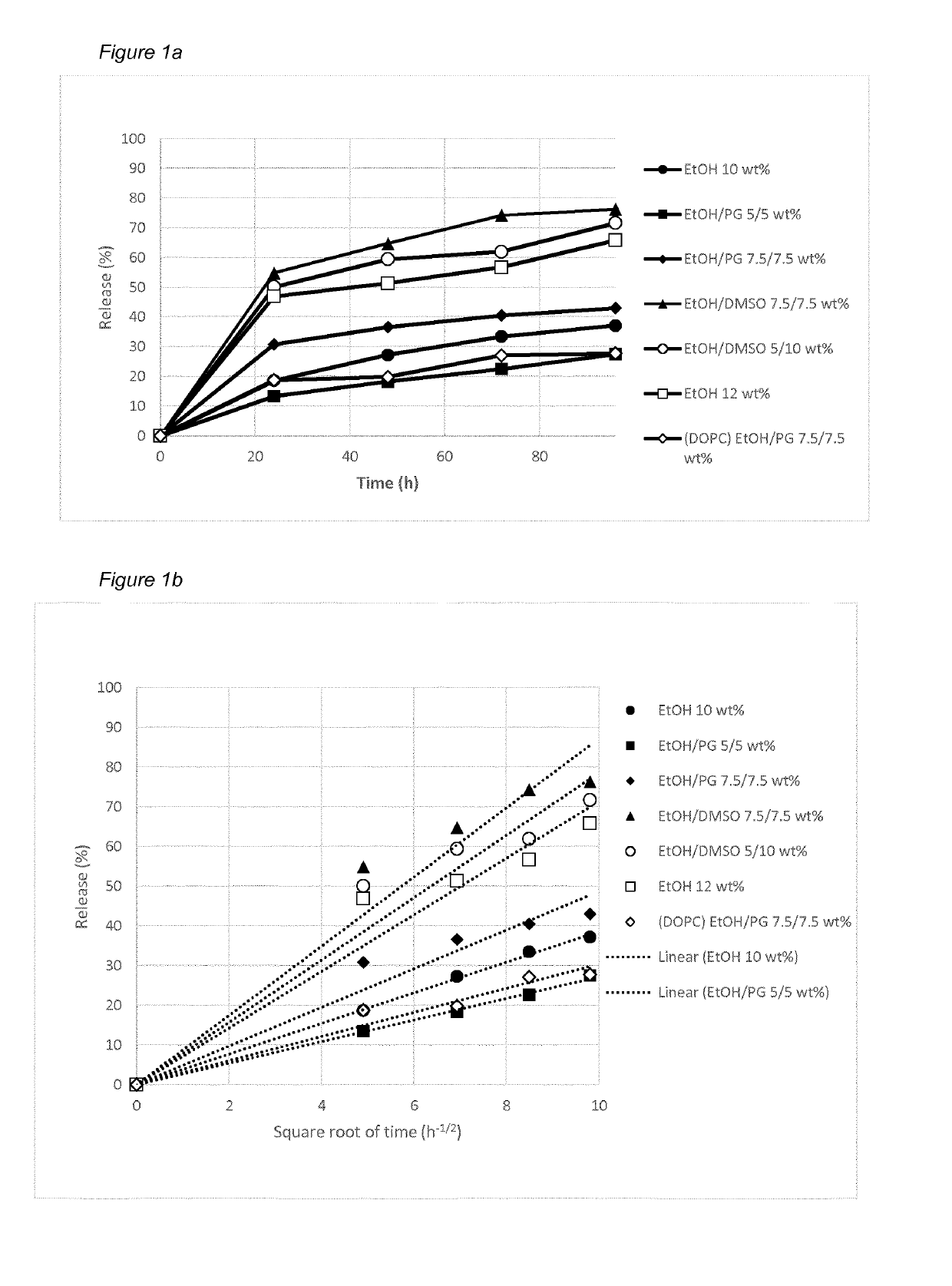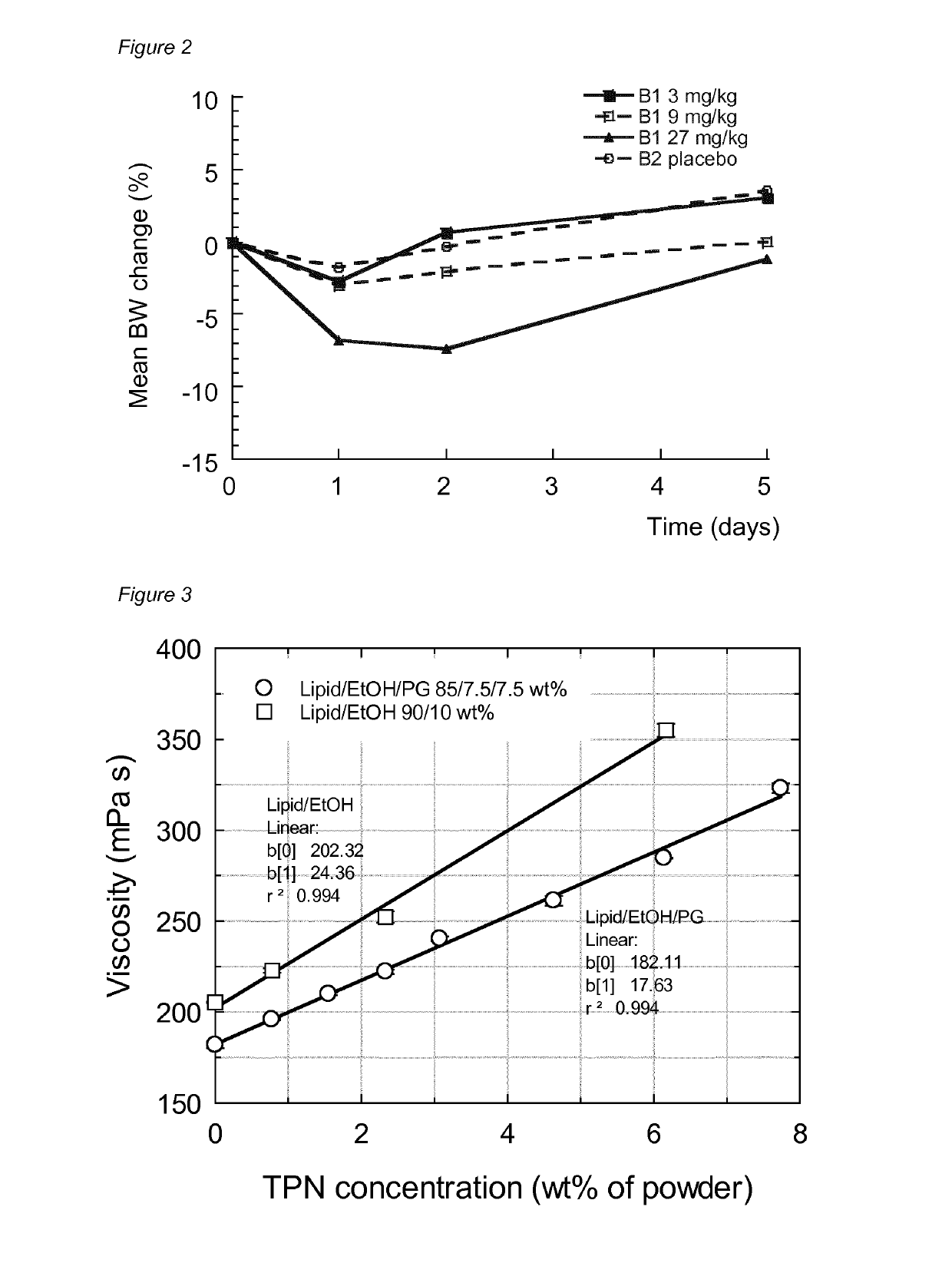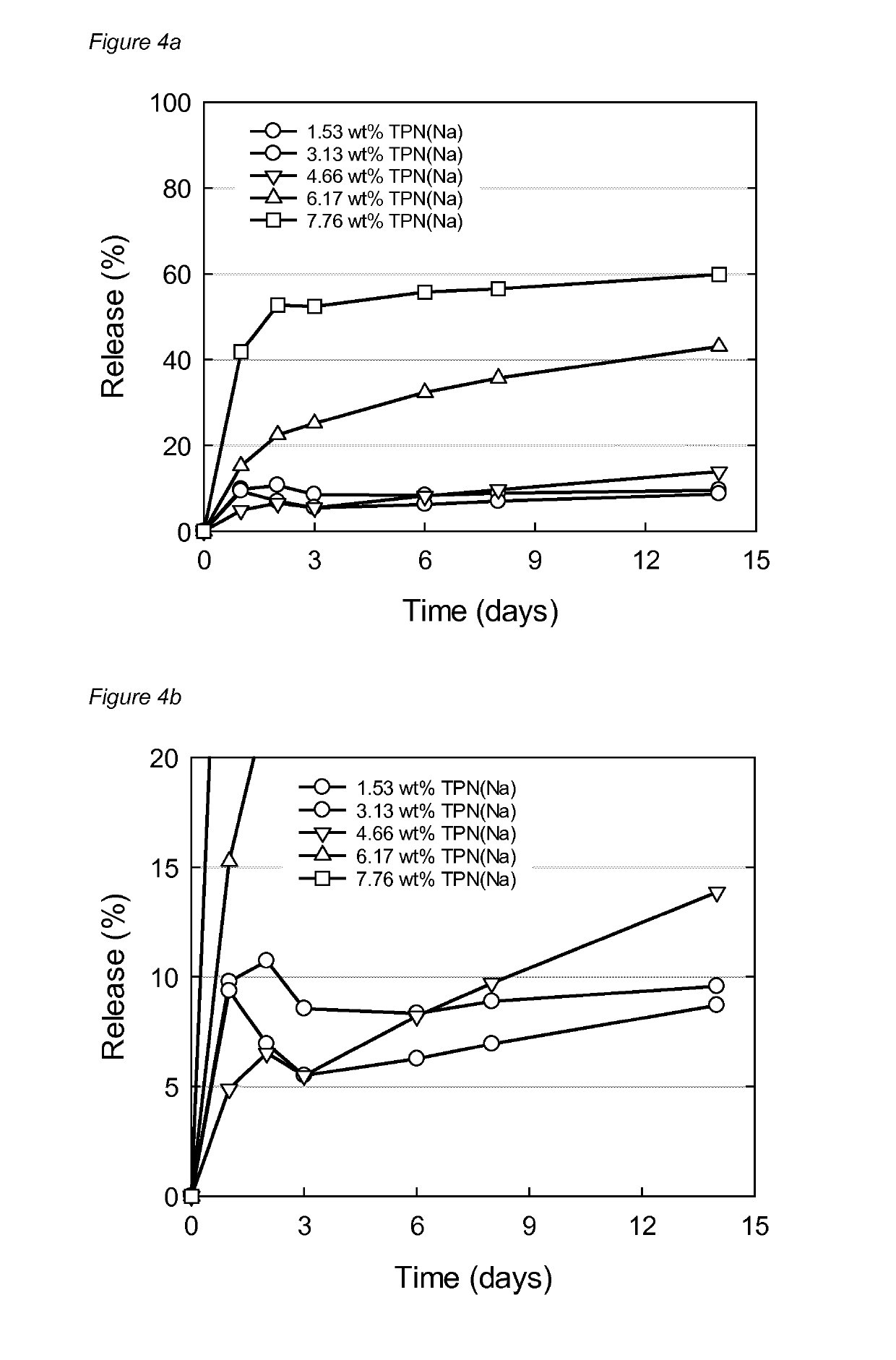Prostacyclin analogue formulations
a technology of prostacycline and analogue formulation, which is applied in the field of formulation precursors, can solve the problems of poor compliance, unsatisfactory or even dangerous effects, and carries the risk of infection and thrombosis
- Summary
- Abstract
- Description
- Claims
- Application Information
AI Technical Summary
Benefits of technology
Problems solved by technology
Method used
Image
Examples
example 1
n of TPN(Na) Solubility and In Vitro Release
[0303]The solubility was assessed by adding TPN(Na) to respective lipid stock mixtures followed by mixing on a roller mixer at room temperature (RT) until mixed completely into clear homogeneous liquid solution. During preparation samples were visually inspected. Results showed that TPN(Na) has good solubility in a variety of pre-formulations and that a drug load of at least 7 wt % (˜78 mg TPN(0) / mL) is feasible. As shown in Table 1, measured viscosities of the formulations range between 185-628 mPas depending on co-solvent type, concentration and composition.
TABLE 1Viscosities of various pre-formulations containing 7 wt % TPN(Na).FormulationComposition (wt %)Viscosity (mPas)A1TPN(Na) / GDO / SPC / EtOH3907.0 / 41.5 / 41.5 / 10.0A2TPN(Na) / GDO / SPC / EtOH / PG6287.0 / 41.5 / 41.5 / 5.0 / 5.0A3TPN(Na) / GDO / SPC / EtOH / PG3647.0 / 39.0 / 39.0 / 7.5 / 7.5A4TPN(Na) / GDO / SPC / EtOH / DMSO3057.0 / 39.0 / 39.0 / 7.5 / 7.5A5TPN(Na) / GDO / SPC / EtOH / DMSO3977.0 / 39.0 / 39.0 / 5.0 / 10.0A6TPN(Na) / GDO / SPC / EtOH / NM...
example 2
ation of Pre-Formulations with TPN(Na) in Rats: Formulations and Body Weight Change
[0306]The primary objective of this pilot study was to evaluate the tolerability of TPN, both locally and systemically following single subcutaneous injections of pre-formulations with TPN(Na) to rats (formulation compositions are given in Table 2). The study was designed as a dose escalation study, with doses of administration of 3, 9 and 27 mg / kg TPN (Table 3).
TABLE 2Formulation compositions used in the pilot rat study.FormulationComposition (wt %)B1TPN(Na) / GDO / SPC / EtOH / PG3.1 / 43.45 / 43.45 / 5.0 / 5.0B2GDO / SPC / EtOH / PG45.0 / 45.0 / 5.0 / 5.0
TABLE 3Treatment groups and doses of TPN used in the pilot study.Dose ofDoseTreatmentNo. ofRoute ofTPNvolumegroupanimalsFormulationadministration(mg / kg)(mL / kg)13B1s.c.30.1123B1s.c.90.3333B1s.c.27 1.0043B2s.c.—1.00
[0307]FIG. 2 shows the mean relative body weight change during the study. Formulations B1 and B2 were monitored in the pilot study for injection site erythema / edema ...
example 3
Nanostructure of the Fully Hydrated Pre-Formulations as a Function of Different Amounts of TPN(Na)
[0321]Formulations L to AA below were prepared which compositions and measured viscosities are given in Table 6 and FIG. 3, respectively.
TABLE 6Formulation codes and compositions usedfor nanostructural evaluation.SPC / GDO / EtOHSPC / GDO / EtOH / PG(45:45:10)(42.5:42.5:7.5:7.5)FormulationTPN(Na) (wt %)TPN(Na) (wt %)L0.00—M0.78—N1.53—O2.33—P3.13—Q4.66—R6.17—S7.76—T—0.00U—0.77V—1.55W—2.33X—3.07Y—4.63Z—6.14AA—7.74
[0322]The nanostructure of the fully hydrated formulations from Table 6 was evaluated using small angle X-ray diffraction. Briefly, about 100 mg of the formulation was injected into 5 mL PBS buffer and left to equilibrate at ambient RT in still standing vials for 8 days before SAXD measurements. The nanostructure of fully hydrated formulations as a function of TPN(Na) concentration was studied using synchrotron SAXD measurements, performed at the 1911-4 beamline at MAX IV laboratory (Max I...
PUM
| Property | Measurement | Unit |
|---|---|---|
| wt % | aaaaa | aaaaa |
| wt % | aaaaa | aaaaa |
| mean pulmonary artery pressure | aaaaa | aaaaa |
Abstract
Description
Claims
Application Information
 Login to View More
Login to View More - R&D
- Intellectual Property
- Life Sciences
- Materials
- Tech Scout
- Unparalleled Data Quality
- Higher Quality Content
- 60% Fewer Hallucinations
Browse by: Latest US Patents, China's latest patents, Technical Efficacy Thesaurus, Application Domain, Technology Topic, Popular Technical Reports.
© 2025 PatSnap. All rights reserved.Legal|Privacy policy|Modern Slavery Act Transparency Statement|Sitemap|About US| Contact US: help@patsnap.com



